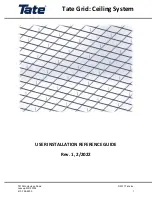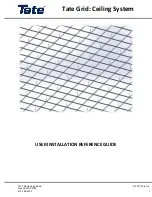
Operation - Ground Drive
Page
20
07/18
Use the transport lock if travelling
between paddocks or across roads.
Setting Application Rates
The application rate is controlled by:
1. The spread width of the product.
2. The bulk density of the product.
3. The gearbox ratio selected to run the feed
chain.
4. The rear door height setting.
Spreading Width
The maximum spread width, or bout width
for various products is determined by a
material’s bulk density, granule size and granule
shape. Some material will spread to wide widths,
such as granulated single super, while lime and
gypsum will only be capable of spreading to a
narrow width.
Refer to the table 17 & 18 on page 13 for
approximate spread widths for various products.
Fig.30 Bout width accuracy test.
To confirm the width for the actual product
being spread it will be necessary to field-test the
specific product and spreader being used.
This process, if done correctly, involves
the collection of spread material in special trays
set out across the paddock at even spacings.
The second and more simplistic method to
determine the approximate spread width is to
estimate the width by eye. This can be done by
spreading a small amount of product at the
desired rate onto clear ground or onto a length of
shade cloth stretched out and pegged to the
ground that contrasts with the fertiliser. This
should demonstrate the approximate bout width
and the tapering off of product at the extreme
edges of the spread.
It may be necessary to drive over the same
path 2 or 3 times during the test if spreading light
rates of granular fertiliser.
The bout width is the distance that you can
drive apart on the paddock, maintaining even
coverage of product across the entire paddock.
The bout width will be less than the overall spread
width.
Determining Bulk Density
To determine the door and gearbox setting
it will help if you know the bulk density of the
particular product. This is done by using the
density meter that is supplied with the spreader
and by carrying out the following steps.
Fig.31 Density meter.
1. Fill the meter with product and level off.
2. Balance on ring and slide weight out until level
bubble is between the marks.
3.
Read density from the scale in tonnes per
cubic metre (top scale).
Содержание 7312
Страница 2: ...07 18 Page Intentionally Blank ...
Страница 4: ...07 18 Page Intentionally Blank ...
Страница 12: ...ORDERING PARTS Page 8 07 18 PART No DESCRIPTION QTY COST DATE ...
Страница 43: ...07 18 7390 7312 PARTS ...
Страница 44: ...General Spare Parts Page 40 06 18 ...
Страница 48: ...06 18 Page Intentionally Blank ...
Страница 52: ...Rear of Bin Spare Parts Page48 07 18 ...
Страница 58: ...Braked Axle Assembly 9T Spare Parts Page54 07 18 ...
Страница 60: ...Braked Axle Assembly 12T Option Spare Parts Page56 07 18 ...
Страница 72: ...VRT Hydraulic Components Spare Parts Page68 07 18 VRVRT Hydraulic Schematic Option ...
Страница 75: ...Page Intentionally Blank ...
Страница 76: ...OPTIONAL PARTS ...
Страница 77: ...Tarp Kit Option Page73 07 13 ...
Страница 80: ...Page Intentionally Blank ...
















































